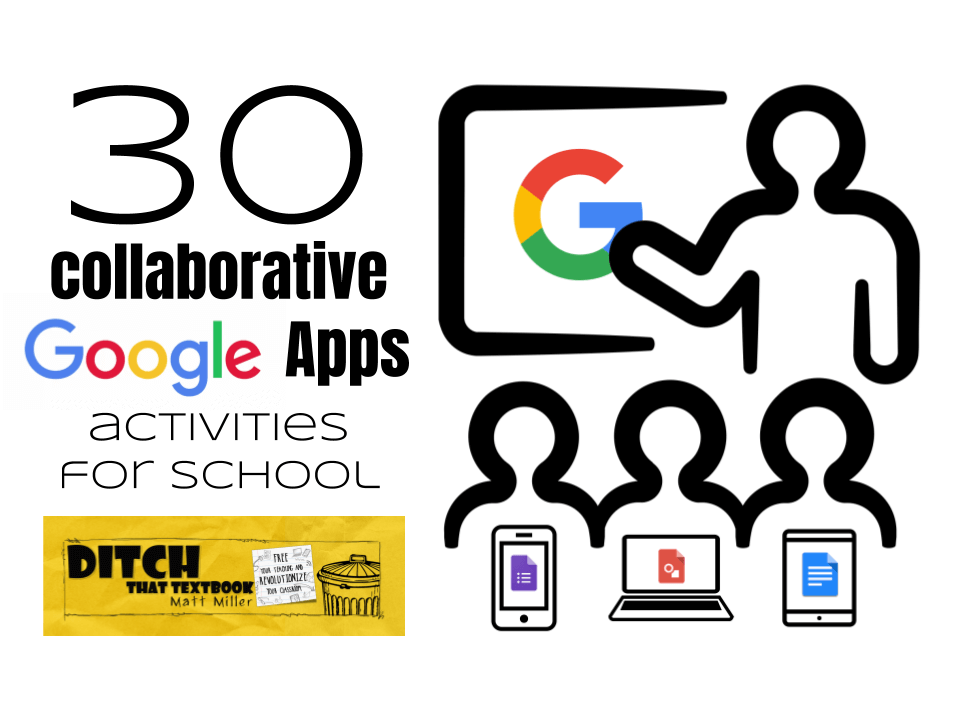
G Suite Apps are collaborative, which makes them highly powerful. They offer opportunities for students to engage unlike ever before. Here are 30 ideas for using them with your class.
G Suite has revolutionized education. With its highly collaborative, online/offline format — and its attractive price tag (free!) it provides students and teachers with effective tools for a blended learning environment.
The way that G Suite is interactive and easy to share is powerful. Our students can share ideas in real time with other students around the world, an option that never existed before.
There’s so much you can do with these apps in class to get students — AND teachers — working together.
Here are 30 collaborative G Suite apps activities that you can use in your own classroom.
GOOGLE DOCS
1. Shared notes
Students often have lots of information to share with each other when they work together as a group. By sharing a document with group members, they can all add ideas and resources — and see everyone’s changes in real time.
A table of contents can make a large document more manageable. It can also help collaborators find their area on the page quickly and easily.
Admin application: A document like this can let everyone on staff share info/notes/etc. without having everyone digitally step on each other’s toes as they modify the document. Teachers can use this in committee work and at staff meetings.
2. Rethinking rough drafts
With the comments feature in Documents (and other Google Apps), rough drafts aren’t a paper students submit to a teacher. They’re a process. Teachers can guide students throughout the entire writing assignment so there are no surprises when it’s time to turn work in.
3. “Add and pass” activity in docs
Have you ever played a game where someone begins a story then the next person adds to it, the next adds a little more and so on? This is a digital version of that. Begin with an image at the top of a blank document (perhaps a picture of a spooky house, a historical figure, a scene from a story or anything you want!). Share the document with a group of students. Number students off. Student 1 writes the first part of the story. Student 2 begins where they left off adding to the story but giving it their own spin. This continues until you have a completed story. You can give students a certain number of words or sentences they need to add or just let them go. Want some more guidance? Check out my post Add and pass: A fun activity to get them moving AND creating for step-by-step instructions and ideas for using them in class!
GOOGLE SLIDES
4. Shared presentations
Create a presentation with one slide per student and give students permission to edit it. Then assign an activity — some quick Internet research, a writing prompt, an image search to find an example, etc. When they’re done, show the presentation on a projector. It’s student work instantly on display. Want some more guidance? Check out my post on student collaboration in shared Google Slides for step-by-step instructions and ideas for using them in class!
5. Virtual art gallery
This goes for any creative student work — poetry, video, visual art, etc. Display the work in a presentation via text, image or video. Share the presentation with permission for anyone to add comments, or embed a live version of the presentation in a website for others to see.
Kick this assignment up a notch with a Google Earth and Slides appsmash! Google Earth is a visually stunning experience, giving users a first-person view of life from places around the globe. Google Earth is great for giving virtual tours, but there’s a simpler and faster version of it. Take screenshots of scenes from Google Earth and paste them in a Google Slides presentation. Add a title and/or some text description. With lots of slides, a virtual tour can happen quickly and meaningfully.
6. Collaborative “Caption This” activity
When you add a speech bubble or thought bubble to an image, you let students speak or think for the subject of the photo. Understanding different viewpoints is also a great way to delve deeply into a topic. When students can take the place of the person in the image, it helps them see what’s happening in a whole new light. When students work together in groups, the conversations around what the characters should be saying brings the “Caption This” activity to a whole new level.
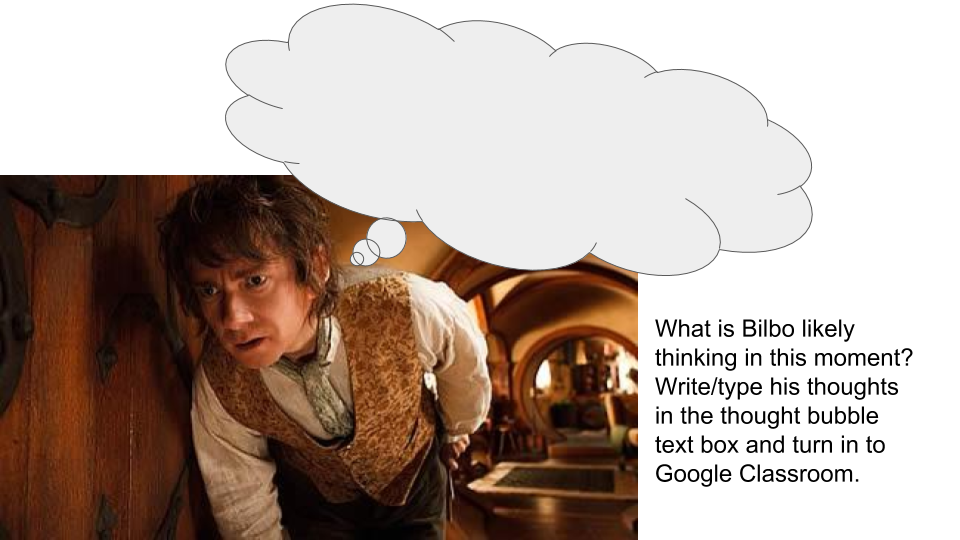
- Select a set of pictures that either introduces your current lesson focus or is key to your subject for the lesson and let students caption them as a group. You can add the images to a Google Slides presentation and share the same set of images with each group of students through Google Classroom. OR, you can have students create a new Google Slides presentation share it one another and add the images themselves.
- Add a thought bubble or speech bubble to each of the pictures. Give students a prompt for filling in the bubble, or give them freedom!
- When they’re done, have students turn the image into you via Google Classroom (or however you collect digital work) and share each group’s presentations with the class. Have groups share why they chose their captions, how it differs from other groups, and how they came up with it as a group.
7. Create a class yearbook
This idea comes from Jennifer Scott, an English teacher, and technology leader in California. Rather than pay companies for high-priced software, students use Google Slides to create their own Basic Yearbook. Think of Google Slides as a blank canvas waiting for student graphic designers.
To create a unified look, students create Layouts with Image templates. These layouts can be duplicated and their images replaced with images shared either with Google Drive or Google Photos via Google Classroom. In the example below, the image templates in the Word Art Yearbook layout are replaced with photos from the #Mex16 Google Innovator Academy. Captions are written to preserve memories.
A layout like this…
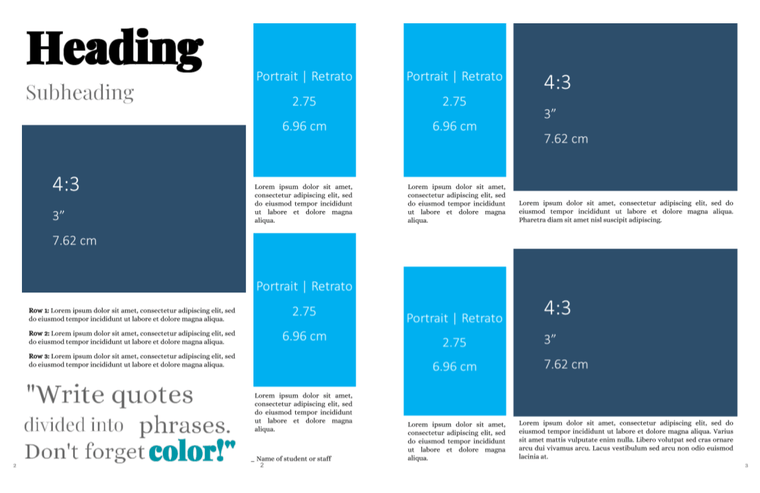
Layout from Jennifer Scott shared in her guest blog post “Create a low-cost, printed school yearbook in Google Slides.”
…becomes this.
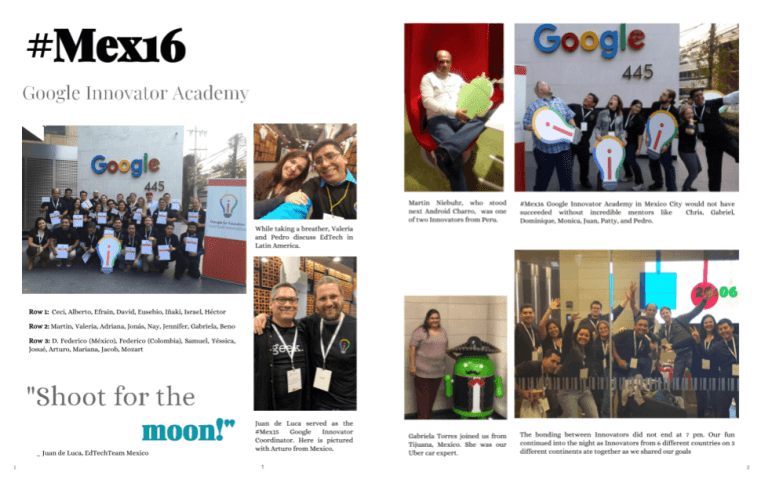
Example from Jennifer Scott shared in her guest blog post “Create a low-cost, printed school yearbook in Google Slides.”
SlidesYearbook.com was born in December 2016 and continues to grow. Easy-to-use directions are available on the website in both English and Spanish. If creating a yearbook from scratch is not an option this year, feel free to use already created templates. Start with a class yearbook and move to a schoolwide yearbook next year.
8. Digital brain dumps
Use a more brain-friendly way to study! Retrieval is the practice of studying by pulling information from the brain. That’s different from traditional studying methods, like re-reading chapters and reviewing notes. Retrieval can be done with a brain dump, where students write down everything they remember about a topic. A collaborative brain dump lets students do that writing on their own slides within the same slide presentation. Each student gets a slide for his/her own brain dump. Then, as a group, the class can identify what the class knows well and what each student left off of his/her own slide.
More Google Slides ideas:

GOOGLE SHEETS
9. Quick “do now” activities
Create a spreadsheet and assign each student a row on it. Ask a question to gauge comprehension of a new concept in class. Students type their answer in the shared spreadsheet but don’t hit “enter” until you tell them. When they do, it’s fast, instant feedback on what they know.
10. Weather/environment lab
Science classes (or any class, really!) can connect with one or more classes in another city, state, province or country and gather data about the weather or environment around them. Log it in a Google Spreadsheet with a page for each location. Compare and contrast the world around you.
11. Sign-up sheets
They’re a necessary evil for many activities in schools. By making and sharing a digital place to sign up, you eliminate paper and make your list accessible anywhere. Create a spreadsheet that can be edited by anyone with the link (using the blue “Share” button).
12. Give students their own tab automatically
In a spreadsheet, a tab is a perfect workspace to give each student. It’s easy to access each student’s work. Every student has virtually unlimited space for working. By using the RosterTab template by Alice Keeler, you can generate personalized tabs for each student. Provide a roster (by typing names or copy/pasting them) and run the script. There are instructions in this blog post.
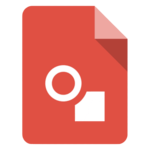
GOOGLE DRAWINGS
13. Interactive whiteboard
Create a Google Drawing and share it with students, giving them permission to edit. Display the drawing on a projector screen. Students can add text and shapes, draw arrows to important ideas and connect concepts with lines. Everyone can make changes, and anyone can watch — in class or away. Want some more guidance? Check out my post 10 online whiteboard options for remote learning for more options and ideas!
14. Informational graphics
In traditional research reports, students gather information, analyze and organize, and then present their findings in essay style. They could demonstrate all of those findings in another way — with an informational graphic! Infographics are all over social media and are very popular. Learning to create an infographic is a useable skill in the real world.
15. Timelines
Students can work together to add text and pictures to mark events on a timeline. Use the same elements from the informational graphics above to create timelines. Add a horizontal line to a drawing. (Pro tip: Hold down shift while drawing the line to make it truly horizontal and straight!) Add information for the different dates on the timeline and illustrate them with images. When they’re finished, the image can be saved as an image file (JPEG or PNG) or a PDF file. It can also be embedded in a site to share with others.
16. “Add and pass” activity in Google Drawings
To spark creativity for the day, have students create a new drawing and add a few elements to it (some shapes, lines, etc.) and pass it digitally to another student (through a shared folder or with a link). View the students’ work in class afterward. These drawings can be used as writing prompts or story starters too. You can even use these images as the prompt for the “add and pass” activity in docs mentioned above! Want some more guidance? Check out my post Add and pass: A fun activity to get them moving AND creating for step-by-step instructions and ideas for using them in class!
17. Collaborative interactive posters.
Creating posters is an activity that’s a staple in many classrooms. If you don’t want to hassle with glue sticks, markers and magazines for cutting images out, Google Drawings can help. Drawings is a great spot for creating interactive posters. Regular posters are static and only contain the information you can fit on them. Interactive posters have clickable links, making the poster just a starting point for more information.
How to do it: Students create a Google Drawing and share it with the other members of their group. They add text boxes with information and shapes to help organize (think of the construction paper behind the text). They can add Creative Commons images by going to Insert > Image … > Search tab to be good digital citizens. (This falls right in line with my post on how to find and use images the right way in class!) They can highlight text and push Ctrl+K or go to Insert > Link … to make clickable links in their text. Want some more guidance? Check out my post on interactive Google Drawings posters with an example you can click on and copy into your Drive if you’d like.
18. Picture This and Take a Stance.
Instead of asking students to write a quote or caption like in the caption this activity above, let’s start with a quote!
- Have students find a quote from your content or a character/historical figure and add it in a speech/thought bubble to a Google Drawing. Students will then share it with a partner.
- Their partner adds a picture that illustrates the quote. They can find an image using “Insert” and “Image” and “Search the web.”
- Students explain the scene. Students can add a text box or a shape at the bottom of the image for typing text to explain the scene.)
- Once they have added their explanation of the scene, then they form an opinion/take a stance and write about their opinion/stance. You can even ask students to add a Bitmoji, avatar, emoji or other images that represent how they feel and have it take a stance. (Note: Some Bitmoji images are inappropriate for younger children. You might want to use emojis instead OR just download some Bitmoji images in a Google Drive folder you can share with students.)
When they’re done, have students turn the image into you via Google Classroom (or however you collect digital work).
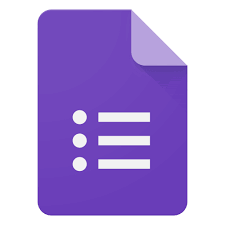
GOOGLE FORMS
19. “Choose your own adventure” stories
This one can take some serious student planning, but the results are worth it. Using the “Go to page based on answer” feature in Forms, students can work together to create a story where the reader chooses how the story unfolds. Students write the story and give the reader options with multiple-choice questions.
20. Exercise or reading logs
There are many things students can log using forms. Teachers gather information using forms. Student data is gathered in a spreadsheet, where it can be sorted and analyzed. Teachers can display any information they see as pertinent to classes for discussion or analysis.
21. Digital share out
Students can use a Google Form to share their learning. Have students respond to the same Google Form sharing their information, ideas, reflection and a link to their work. Provide a “view only” link to the spreadsheet of results to the class. That way, everyone can see everyone else’s ideas all in one place. Changing the sharing permissions to “anyone with the link can comment” allows students to give feedback to one another within the same Google Sheet.
GOOGLE MEET
22. Mystery Meet
Using Meet — Google’s video chat service — classes from different parts of the country or the world can play this “guess where we are” game. Find a class and video chat using Meet. Students ask each other yes/no questions until they guess where in the world the other class is. A Mystery meet is a great, fun, engaging activity that more classes should take advantage of.
23. Sharing learning
After you’ve had a Mystery Meet, continue that connection between the two classes. Connect and share what each class has been learning — or share in the same lesson across many miles. Ask questions. Reflect. Add information. Use each other as a resource. It’s a great way to connect your classroom to the world.
24. Guest speakers
Can’t afford to fly in an author, researcher, professor, historian or scientist that’s an expert in what you’re studying? Try to arrange a Google Meet. Even a short Meet can make a long-lasting connection with students. All speakers need is a webcam, an Internet connection and some time. You never know if they’ll do it until you ask!

GOOGLE SITES
25. Share and discuss student work
By creating a site for student work — either individual student ePortfolios or a class site — you’re giving your students’ hard work at home online. You also give it a global audience. Anyone in the world can find and comment on their work. Sure beats writing for just the teacher — an audience of one.
26. Create a class or group Breakout EDU Digital
Like the choose your own adventure activity this will also take some serious planning and combines quite a few G Suite apps embedded in a Google Site. With Google Forms and data validation, students can create a digital version of the locked box and hasp from Breakout EDU then use presentations, drawings, docs or other puzzles making tools to create clues.
Be sure to check out this Wakelet collection of ready to play Breakout EDU Digital games for you and your students. It’s a great idea to experience the game from a player’s perspective before diving in and creating one of your own.
Mandi Tolen, a Missouri math teacher, and #DitchBook Twitter chat regular, created a Breakout EDU Digital game for her students. It’s called, “Digital Breakout Data Cruncher.”
Mandi Tolen’s Breakout EDU Digital game, “Digital Breakout Data Cruncher”. Click here to check it out!
She’s a big fan of using Breakout EDU Digital to get kids excited about learning. “BreakoutEDU is a great ‘hook’ for a lesson,” she said. “It provides opportunities for students to problem solve and persevere. While solving the Breakout, students will be learning about the content. It would also be amazing to have students create their own BreakoutEDU.”
Mandi’s steps:
- You can create a digital BreakoutEDU using Googles Sites as the shell. By inserting a two column table onto the main page of your site and embedding a Google Form on one side and Google Drawing image on the other, you can create an exciting adventure for your students.
- On the Google Form, you will insert a timer from YouTube (BreakoutEDU has one you can use or find another if you want less then 45 minutes) and make sure you validate each answer so students can’t continue until they have entered the correct clue.
- In Google Draw, create your image with invisible hotspots linking to the websites or clues. To create an invisible hotpot, create a shape on top of the image and change the line and fill to transparent. You can still insert a link into the invisible shape. Make sure its order is in the front. Have a few people test your BreakoutEDU to make sure they can solve the clues. You know what you intended but you want to make sure the clues aren’t to difficult (or easy.)
Play “Digital Breakout Data Cruncher” here: https://sites.google.com/site/digitalbreakoutdatacruncher/
And check out 40+ FREE digital escape rooms (plus a step by step guide for creating your own) for more resources and ideas.

GOOGLE CLASSROOM
27. Share project resources
Students can use the stream in Google Classroom as a place for posting ideas and conversation — to list sites, articles, and ideas for a collaborative project.
28. Take a quick poll
Create a question in Google Classroom. You can create short answer or multiple choice questions and can also have students reply to one another.
29. Create a Frequently Asked Questions section (or document)
Create an “anyone can edit” FAQ document for frequently asked questions. When any student asks a question, type your response (and the question) in the document. Or ask the student to type a summary of your answer in the document for other students! In fact, students can be encouraged to add questions their peers might come across with their own responses
30. Group activities
Google Classroom allows you to assign an activity to a group. Then, all the group members are all together in one place. You won’t have to check and double check who is in which group.
What are other ways to use Google Apps to help students, teachers and others at schools collaborate? Which of these are you most apt to use? Share your ideas in a comment below!
For notifications of new Ditch That Textbook content and helpful links:
Are you looking for quality, meaningful professional learning that both equips and inspires teachers?
Matt provides in-person and virtual keynotes, workshops and breakout sessions that equip, inspire and encourage teachers to create change in their classrooms. Teachers leave with loads of resources. They participate. They laugh. They see tech use and teaching in a new light. Click the link below to contact us and learn how you can bring Matt to your school or district!
Is Matt presenting near you soon? Check out his upcoming live events!

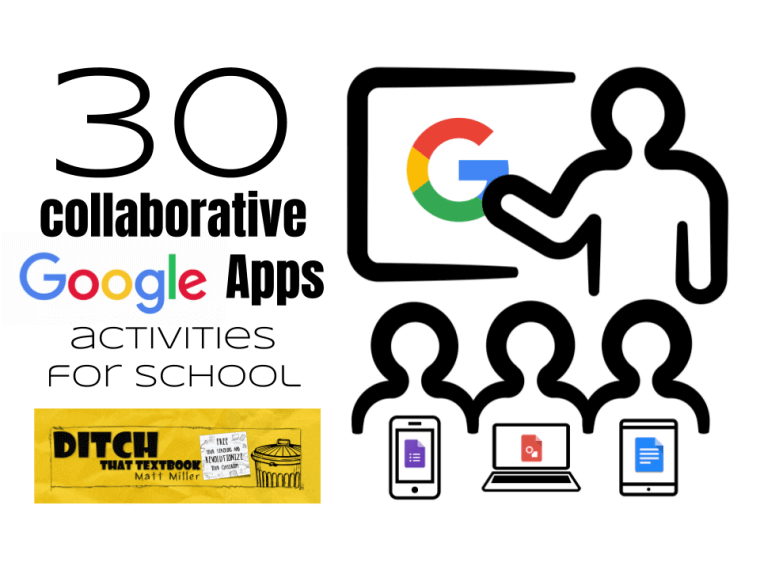
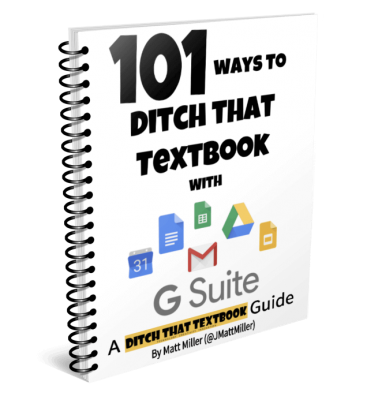

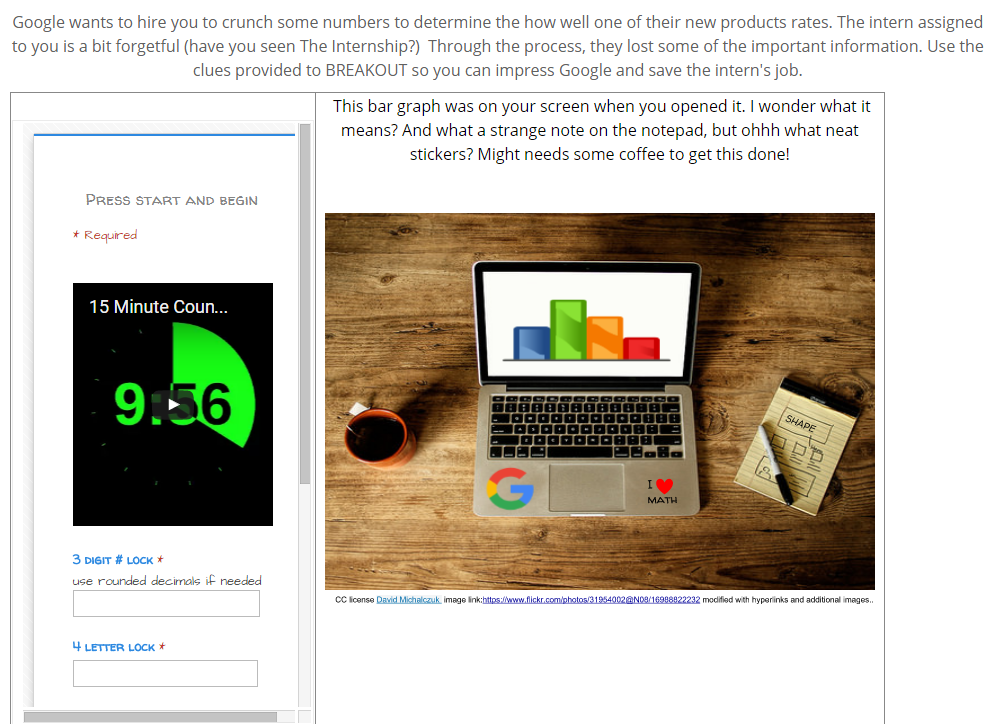


These are some good activities that we should be focusing on. Great efforts
Sounds like some great creative ideas.
At our school library, students make “Book Hooks” in Google Slides. Students write a mini book review on one Google Slide and make it fancy and pretty. Then we use Aurasma app to make the Book Hooks pop up in augmented reality when students scan the covers of the books they reviewed. Here’s a few examples from one of my websites: https://sites.google.com/site/jbssio2017/home/student-work
Yeah, Google Hangouts has gotten a lot of buzz, but I’ve been a big fan of R-HUB’s web video conferencing service b/c it’s easy to use (like Google), but it’s also much more secured.
Matt I just love your stuff and can’t help keep drinking from your great wealth of knowledge.
Thanks!
Didn’t know what “Moderator” was. Tried and it said, “Moderator has gone away”.
Bought your book…hope to go paperless.
In the process of getting my certification…Level 1.
[…] Source: 20 collaborative Google Apps activities for schools | Ditch That Textbook […]
In addition to using Google Docs as shared notes and rough drafts for students, the concept of lesson planning in Google Docs is amazing. Grade levels or departments organize documents by topic or part of year and collaborate to create and share amazing lesson plans between a group of teachers. After teaching the lesson plan, teachers can add comments on things to change for the next time it is presented and watch as the lesson grows over time!
[…] UNITE students by researching and assigning highly collaborative group projects in Presentations, Sheets, or Drawings that […]
[…] 20 Collaborative Google Apps Activities for Schools by Matt Miller […]
[…] 20 Collaborative Google Apps Activities for Schools by Matt Miller […]
[…] 20 Collaborative Google Apps Activities for Schools by Matt Miller […]
[…] 20 Collaborative Google Apps Activities for Schools by Matt Miller […]
[…] 20 Collaborative Google Apps Activities for Schools by Matt Miller […]
[…] 20 Collaborative Google Apps Activities for Schools by Matt Miller […]
[…] 20 Collaborative Google Apps Activities for Schools by Matt Miller […]
We use Chrome in Primary to manage year group bookmarks and resources for learning so all young students have good links renewed for each topic/enquiry/project when they open the browser.
[…] integrate these tools into learning. Check out Richard Brynes Google Tutorials or Matt Millers Ditch That Text Book for […]
great site…
I’m looking for a way to transfer my bell ringer activity, Daily Oral Language (DOL), from a notebook and pencil activity to a Chromebook activity. I have about 130 students, and I need to be able to check their work every few weeks. I’m looking for either a separate app to do this or a way to do it using Google Docs. Any help would be appreciated.
Hi Dan —
I think that bell ringer activity would be a perfect fit for Google Docs or Google Slides. If you use Google Classroom, students could turn Docs with their bell ringers in to Classroom. You could look at them, add comments to the document itself or to the assignment in Classroom, put a grade on it and return it. This way, the work is sorted by student.
If you wanted the bell ringers sorted by day, you could create a Google presentation and create a slide for each student. When I do this, I assign each student a number so he/she knows which slide to use. Each student writes his/her name as the title and then does the bell ringer activity. I used to use a TodaysMeet chat room to distribute the link to the shared presentation, but now I often include a link to it on my class website and just send students there.
Hopefully one of those sounds like it will work. If not, feel free to ask for more ideas and I’ll bet I can come up with some others!
[…] Retrieved from: https://ditchthattextbook.com/2014/02/03/20-collaborative-google-apps-activities-for-schools/ […]
[…] See on ditchthattextbook.com […]
[…] Thursday, February 27: 20 Collaborative Google Apps Activities For Schools – https://ditchthattextbook.com/2014/02/03/20-collaborative-google-apps-activities-for-schools/ […]
[…] les éléments de la suite google et les applications représentent des outils fort intéressants. voici un lien qui explique […]
[…] See on ditchthattextbook.com […]
[…] 20 Collaborative Google Apps activities for schools […]
[…] URL: https://ditchthattextbook.com/2014/02/03/20-collaborative-google-apps-activities-for-schools/ […]
[…] 20 collaborative Google Apps activities for schools | Ditch That Textbook […]
[…] See on ditchthattextbook.com […]
You ca also use Google drawing for a variety of tasks, here is one I made to annotate a sentence. Part of my ideas for ways for teachers to ditch worksheets. https://docs.google.com/a/delnorte.k12.ca.us/drawings/d/1_Y5sQqIQR5isj1B0fWjfGad12bm90mIuH6tqaSIzR0o/edit?usp=docslist_api
Ahh … ditching worksheets. I love that idea. You’re right, Rae — there’s a ton of things you can do with Google Draw. I love Alice Keeler’s resources, and she has a ton of ideas for using Google Draw. Here’s one: http://www.alicekeeler.com/teachertech/2013/04/21/have-students-create-infographics-using-google-draw/
[…] See on ditchthattextbook.com […]
[…] Google Apps FB page, which includes resources like “20 collaborative Google Apps activities.” […]
[…] 20 collaborative Google Apps activities for schools from “Ditch That Textbook” The link to Kaizena is number 16 in the list of Google Apps activities. […]
[…] See on ditchthattextbook.com […]
[…] 20 collaborative activities for your class […]
[…] See on ditchthattextbook.com […]
[…] 20 collaborative Google Apps activities for schools. Read the full story >>> […]
[…] 20 collaborative Google Apps activities for schools | Ditch That Textbook […]
My students are using Lucidchart. Best diagram tool I have come across and finding it easy to use and has great templates and icons for cross-curricular subject range. Google Apps plugin and full features free for education accounts.
Great idea Mark … I had heard of Lucidchart but haven’t given it a shot yet. Thanks for adding it to the list!
We use Lucidpress for desktop publishing, it saves in the student’s drive.
I also love lucidchart. My students used it when I was teaching them the concept of flowcharting.
Will try it for mindmaps too.
[…] See on ditchthattextbook.com […]
[…] 20 Collaborative Google Apps Activities for Schools […]
[…] See on ditchthattextbook.com […]
[…] See on ditchthattextbook.com […]
[…] See on ditchthattextbook.com […]
[…] See on ditchthattextbook.com […]
[…] 20 collaborative Google Apps activities for schools | Ditch That Textbook […]
[…] See on ditchthattextbook.com […]
[…] 20 collaborative Google Apps activities for schools | Ditch That Textbook […]
Just encountered this blog and enjoy the content. Just one question – what do most of the posts have to do with finding an alternative to traditional textbooks?
Hi Mark — Glad you asked!
The official focus of the Ditch That Textbook blog is: teaching with less reliance on the textbook with an emphasis on educational technology and creative teaching.
I write about the tools and techniques I use to teach without a textbook in my classroom. I also extend it to “ditching the textbook mentality” to teaching from time to time, where I’ll write about education in general or ideas worth discussing (like standards-based grading and 20 percent time).
Hope that clears it up! Glad you found the site and hope you continue to enjoy it!
Creately is another great diagramming app for students. You can use it to draw flowcharts, mind maps, UML, Venn diagrams, graphic organizers and so much more. It’s real-time collaboration features enables you to use it as a shared drawing space to do cool projects. Hope you and your fellow teachers like it.
Disclosure: I work for Cinergix, makers of Creately
Wow, sounds like a great tool. I will check it out. Thanks, Nishadha!
Went to Google Apps through search engine. Appears to be available only for android based equipment. Can I replace Microsoft with Google Apps on my PC and laptop?
Hey Ken!
I use Google Apps through my browser on my computer and through the iOS app (although you’re kind of limited on what you can do with that app). Google obviously likes Android better because it’s Google’s own.
I have practically replaced all of my Microsoft Office suite with Google Apps. I have Office installed on my computer because the tech staff at my school did it, but I rarely use it. Plus, you can open all of your Office files through Google Apps and Google will convert them to Apps files for you (although sometimes — very rarely — the formatting is a bit wonky).
Hope that helps! Let me know if you have other questions!